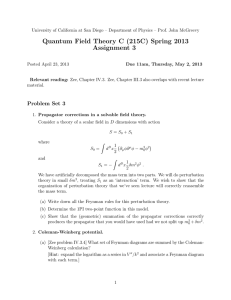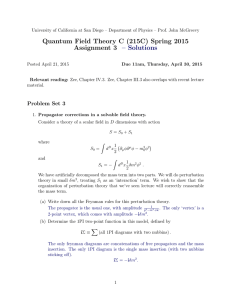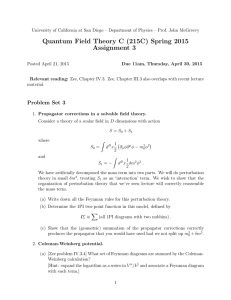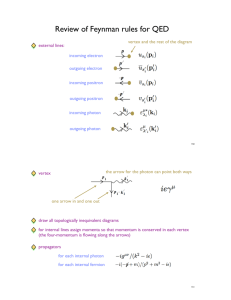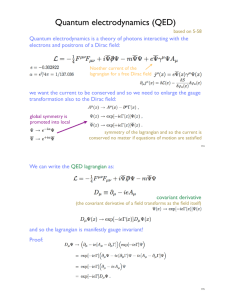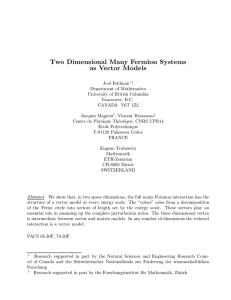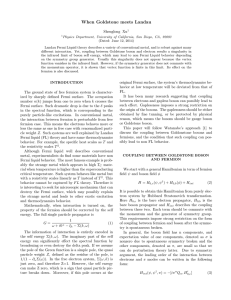Quantum Field Theory C (215C) Spring 2013 Assignment 3 – Solutions
advertisement
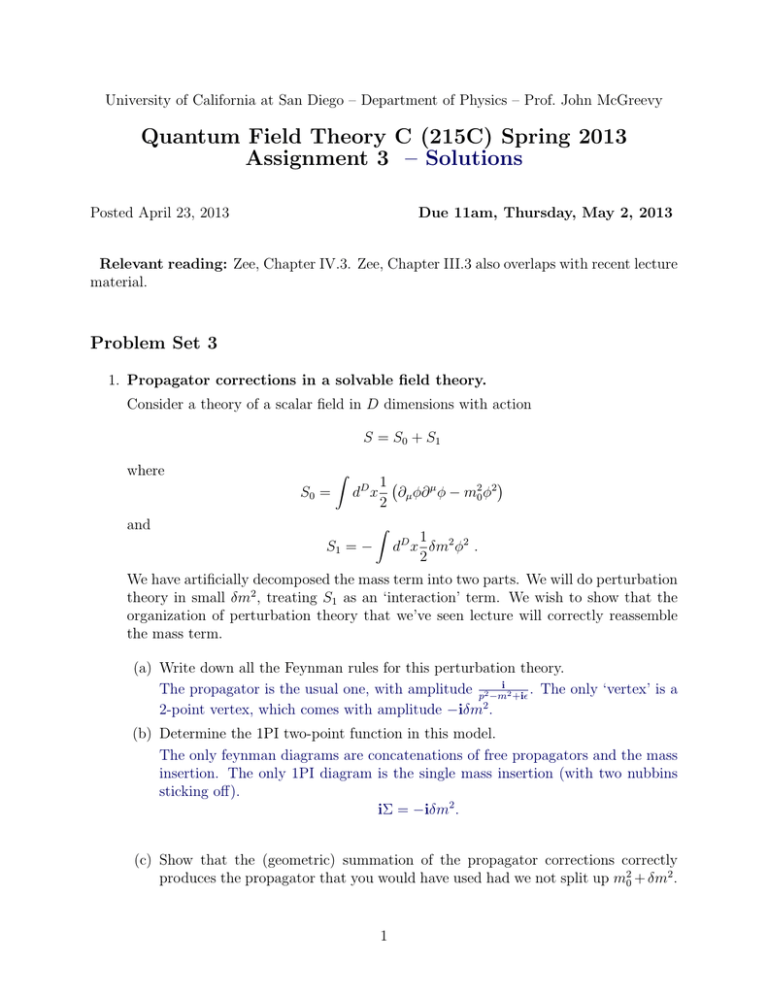
University of California at San Diego – Department of Physics – Prof. John McGreevy Quantum Field Theory C (215C) Spring 2013 Assignment 3 – Solutions Posted April 23, 2013 Due 11am, Thursday, May 2, 2013 Relevant reading: Zee, Chapter IV.3. Zee, Chapter III.3 also overlaps with recent lecture material. Problem Set 3 1. Propagator corrections in a solvable field theory. Consider a theory of a scalar field in D dimensions with action S = S0 + S1 where Z S0 = dD x and 1 ∂µ φ∂ µ φ − m20 φ2 2 Z 1 dD x δm2 φ2 . 2 We have artificially decomposed the mass term into two parts. We will do perturbation theory in small δm2 , treating S1 as an ‘interaction’ term. We wish to show that the organization of perturbation theory that we’ve seen lecture will correctly reassemble the mass term. S1 = − (a) Write down all the Feynman rules for this perturbation theory. The propagator is the usual one, with amplitude p2 −mi 2 +i . The only ‘vertex’ is a 2-point vertex, which comes with amplitude −iδm2 . (b) Determine the 1PI two-point function in this model. The only feynman diagrams are concatenations of free propagators and the mass insertion. The only 1PI diagram is the single mass insertion (with two nubbins sticking off). iΣ = −iδm2 . (c) Show that the (geometric) summation of the propagator corrections correctly produces the propagator that you would have used had we not split up m20 + δm2 . 1 The geometric series for the two-point function results in G(p) = G0 (p) + G0 (p)iΣG0 (p) + G0 (p)iΣG0 (p)iΣG0 (p) + ... = G0 (p) ! 1 i = 2 p − m20 + i 1 − iΣ p2 −mi 2 +i 0 i i = 2 . = 2 2 2 p − m0 + Σ + i p − m0 − δm2 + i 1 1 − iΣG0 (p) 2. Coleman-Weinberg potential. (a) [Zee problem IV.3.4] What set of Feynman diagrams are summed by the ColemanWeinberg calculation? [Hint: expand the logarithm as a series in V 00 /k 2 and associate a Feynman diagram with each term.] Recall that this calculation was the order-~ contribution to the saddle-point expansion of Z 2 [Dφ]ei((∂φ) −V (φ)+Jφ) about φ = φc + ϕ. They are diagrams with a single loop of the fluctuation ϕ, no external ϕ legs, and arbitrary numbers of φc insertions. Then one perspective is to use the Feynman rules for the expansion φ = φc + ϕ, thinking of the potential as a perturbation. For simplicity consider the case where V (φ) = φp is a monomial. The CW potential comes from just one-loop diagrams, so vertices for ϕ in the expansion of V (φ = φc + ϕ) of order higher than two do not contribute – they would turn the one ϕ running in the loop into more than one, and then we would need an extra loop to get rid of it. In the figure, we show the example with V (φ) = φ4 , so that the ‘interaction vertex’ for the fluctuations ϕ, V 00 (φc ) is quadratic in φc . This is an interaction vertex in the same sense as in the previous problem – it’s just an insertion in the propagator. The one-loop diagram with n insertions of the propagator has a cyclic symmetry which rotates the diagram like a clock; this group has order n and so the answer is of the form n Z 1 V 00 (φc ) D d¯ k . n k 2 + i 2 (Actually the diagram also has a reflection symmetry, since ϕ is real; this produces an extra overall factor of 12 .) A little bit more explicitly, the propagators for the fluctuations are −i hϕ(k)ϕ(−k)i = 2 k 00 and the 2-point vertex is −iV (φc ). The solid lines are ϕ propagators, and the dotted lines represent insertions of φc . (b) [Zee problem IV.3.3] Consider a massless fermion field coupled to a scalar field φ by a coupling gφψ̄ψ in D = 1 + 1. Show that the one loop effective potential that results from integrating out the fluctuations of the fermion has the form 2 φ 1 2 (gφ) log VF = 2π M2 after adding an appropriate counterterm. In this problem, the terms in the boson action which do not involve the fermions just go along for the ride. The fermion path integral is explained in Zee §IV. Notice that the fermion mass is m(φ) ≡ m + gφ. The two important differences from the boson case are: • the determinant of the kinetic operator ends up in the numerator Z dψdψ̄ eiψ̄Dψ = det D = e+tr log D R • the trace over single particle states, which previously was tr... = d¯D khk|...|ki now also involves a trace over the spin space: Z X hk|Dαα (k)|ki. tr log D = d¯D k α It is still diagonal in momentum space. Zee explains a trick for getting rid of the gamma matrices, which I will not repeat. One reason we know they must go away is that they have a vector index and we are computing a rotation-invariant quantity which doesn’t depend on any vectors. This gives 2 Z k + m(φ)2 D . VF = d¯ k log k2 As in lecture, I added a (cutoff dependent) constant to eliminate the contribution to the vacuum energy (it also makes Mathematica happier about doing the integral). We can regulate this integral by euclidean cutoff. That gives 2 Z Λ kE + m(φ)2 D Λ VF = d¯ kE log kE2 Z Λ2 2π 1 u + m2 = du log (2π)2 0 2 u 3 = 1 −m2 log m2 − Λ2 log Λ2 + (m2 + Λ2 ) log(m2 + Λ2 2π (1) Don’t forget that m = m(φ) = mψ + gφ here. Interesting effects occur if we set mψ = 0 so that setting φ = 0 makes the fermion massless. We shouldn’t think about values of φ that are close to the cutoff, so we may assume φ Λ in which case the 2nd and 3rd terms in (1) may be expanded as φΛ −Λ2 log Λ2 + (m2 + Λ2 ) log(m2 + Λ2 ' m2 1 + log Λ2 . Since m = gφ, to get a cutoff-independent effective action for φ, we must add a counterterm for the boson mass, δL = B(Λ)φ2 . The problem would have been better-posed had I specified what you can measure – i.e. if I had told you what renormalization conditions to impose – rather than the answer, which determines a family of renormalization conditions with hindsight. A good example of a reasonable RC which gives the stated answer is analogous to our quartic condition in four dimensions: ! 00 Veff (φc )|φc =M 2 = µ2M . This demands that µ2M = 2B(Λ) + VF00 (φ = M ) = 2B − 6 − 2g 2 log(g 2 M 2 ) + 2g 2 1 + log Λ2 so 1 B(Λ) = 2 g2M 2 2 2 µM + 6 + 2g log . Λ2 The important leftover φ dependent terms are φ2 1 2 2 g φ log 2 . Veff (φ) = 2π M 4
